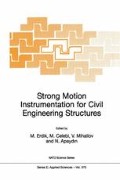Abstract
The instrumentation of special structures such as large bridges, tunnels, monuments etc., contributes towards a better understanding of their dynamic performance, as well as a more accurate and reliable prediction of the earthquake resistance of such large-scale structures. In experimental analysis the classical ways to estimate the modal parameters of the whole structural system, as well as of its structural elements, is either to excite the structure artificially (using, e.g. vibrators, heavy vehicles) or to evaluate the recordings obtained from a weak or strong ground motion. In modeling the behaviour of a civil engineering structure in a realistic way, among the important parameters to be defined are the mass distribution, the damping characteristics, the stiffness of the main load resisting system, the influence of secondary elements and interaction phenomena. Large vibration tests provide reliable data for the evaluation of the influence of such modal parameters. The effective analytical evaluation of the bridge through reliable and effective numerical models is necessary in order to verify the experimental data. By comparing the results of both experimental and analytical approaches and adequately updating the analytical model, a more realistic modeling of the bridge can be obtained. Changes in the modal parameters during the time-life of the bridge can contribute towards detection of damages, such as crackings or any other reasons reducing the stiffness of the structural system. The cable-stayed bridge in Evripos channel (Greece) was selected to apply the aforementioned methodology. The main ambient vibrations recorded are due to traffic, wind and moderate earthquakes at small distances from the bridge. Three-dimensional finite element models of the bridge were created and the dynamic behaviour of the bridge was analysed for both a small and a strong earthquake with high frequency content. Results of the experimental estimation of eigenvalues of the vibration modes are also presented. Finally, comparisons between experimental and analytical values have been performed,
Access this chapter
Tax calculation will be finalised at checkout
Purchases are for personal use only
Preview
Unable to display preview. Download preview PDF.
References
Ewins, OJ. & Griffin, J. (1981) A State-of-the-art assessment of mobility measurement techniques-results for the mid-range structures, J. of Sound and Vibration 78 (2), 197–222.
Gates, J. & Smith, M. (1984) Results of ambient vibration testing of bridges, Proceedings of the 8th Word Conference on Earthquake Engineering, San Francisco, IV, 873–880.
Haibach, E. (1986) Measurement and interpretation of dynamic loads on bridges, Technical Steel Research, Synthesis Report to C.E.C.
Imai, H., Yun, C.B., Maruyama, O. & Shinozuka, %M. (1989) Fundamentals of system identification in structural dynamics, Technical Report NCEER-89-0008.
Karabinis, A.I. (1991) Dynamic characteristics of a typical prestressed highway bridge, International Conference on Dimensions in Bridges and Flyovers, Singapore, 143–149.
Lee, C.G. & Yun, C.B. (1991) Parameter identification of linear structural dynamic systems, Computers and Structures 40(6), 1475–1487.
Hong, K.S. & Yun, C.B. (1993) Improved method for frequency domain identifications of structures, J. of Engineering Structures 15(3), 179–188.
Johanson, R. (1993), System modeling and identification, Prentice-Hall.
Kiousis, P. & Karabinis, A. (1994) Dynamic characteristics of bridges. Proc. of the 11th Greek Concrete Conference, Corfu, Greece, Tech. Chamber of Greece (in Greek).
Paultre, P., Proulx, J. & Talbot, M. (1995) Dynamic testing procedures for highway bridges using traffic loads, Journal of Structural Engineering, American Society of Civil Engineers (ASCE) 121(2), 362–376.
Ewins, OJ. (1995) Modal Testing: Theory and Practice, Research Studies Press Ltd, England.
Broquet, B., Bruhwiler, E. (1999) In situ and model tests and numerical analysis of a curved cable-stayed bridge, Int. Journal of Structural Engineering, I, pp 57–62.
Yun, C.B. & Shinozuka, M. (1990) Program LINEARID for identification of linear structural dynamic systems, Technical Report NCEER-90-0011.
Paultre, P., Chaallal, O. & Proulx, J. (1992) Dynamics and dynamic amplification factors-A review of analytical and experimental findings, Canadian Journal of Civil Engineering 19(2), 260–278.
Lekidis, V.A., Karakostas, C.Z., Papazachos, C.B., Margaris B.N. and Talaslidis D.G. (1997) “Special strong motion array in Evripos bridge: Networking, data aquisition and processing”, Abstract volume of the 29th General Assembly of the International Association of Seismology and Physics of the Earth’s Interior, Geophysical Laboratory, University of Thessaloniki (Ed.), P. Ziti & Co, Thessaloniki, Greece, 352.
Lekidis, V. A., Karakostas, C.Z. and Talaslidis, D.G. (1998) Dynamic Characteristics of the Cable Stayed Bridge on Evripos Channel, Greece, Proceedings 11th European Conference on Earthquake Engineering, CNIT, Paris, France, September 6–11 1998 (in CD-ROM)
Stathopoulos, S. (1987) High bridge over Evripos channel, Proceedings of the 8th Greek Congress of Reinforced Concrete, Xanthi-Kavala 27–29 May 1987, 215–236.
Stathopoulos, S. (1994) Construction of the high bridge over Evripos channel, Proceedings of the 11th Greek Congress of Reinforced Concrete, Corfu, 18-20 May 1994, 326–342.
Lekidis, V.A. (1988) In situ vibration testing for structures under earthquake excitation, Report ITSAK 88-05, Thessaloniki (in Greek).
Sap2000 Nonlinear, v, 6.0 (1996) Computers and structures Inc., Berkeley, California.
Newmark, N. M., Hall W. J. (1987) Earthquake spectra and design, Opt. of Civil Engineering, University of Illinois at Urbana-Champaign. Earthquake Engineering Research Institute.
ATC-3-06 (1984) Tentantive Provisions for the development of seismic regulations for buildings, Applied Technological Council (second printing)
Seed, H. B., Ugas, C. and Lysmer, J. (1976) Site-dependent Spectra for earthquake-resistant design, Bull.Seism. Soc. Am., 66, 221–243.
Vanmarrcke, E., (1999), Spatial variation of earthquake ground motion, invited lecture at the Opt. Civil Engng., 21/4/1999, Aristotle University
Author information
Authors and Affiliations
Editor information
Editors and Affiliations
Rights and permissions
Copyright information
© 2001 Springer Science+Business Media Dordrecht
About this chapter
Cite this chapter
Lekidis, V.A., Karakostas, C.Z., Talaslidis, D.G. (2001). Instrumentation, Measurements and Numerical Analysis of Bridges: An Example of the Cable-Stayed Bridge on Evripos Channel, Greece. In: Erdik, M., Celebi, M., Mihailov, V., Apaydin, N. (eds) Strong Motion Instrumentation for Civil Engineering Structures. NATO Science Series, vol 373. Springer, Dordrecht. https://doi.org/10.1007/978-94-010-0696-5_33
Download citation
DOI: https://doi.org/10.1007/978-94-010-0696-5_33
Publisher Name: Springer, Dordrecht
Print ISBN: 978-0-7923-6917-2
Online ISBN: 978-94-010-0696-5
eBook Packages: Springer Book Archive

